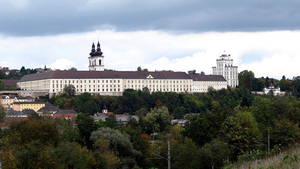Kremsmünster

Kremsmünster is a township in the “Traunviertel” in Upper Austria. Its population is 6,500. Agriculturally, the region between Enns and Traun is said to be the “granary” of Upper Austria. The softly rolling hilly area extends to the Alps in the south and to the so-called “Mostviertel” in the east. The three monasteries of St. Florian, Kremsmünster and Schlierbach prove the former strong impact of the church on the economic development of the region as well.
After the breakdown of the Roman Empire, from the 6th century onwards Avars and Slavic people began to settle in the former Roman province of Noricum, part of which was the Traunviertel, too. About the same time, in the midth of the 6th century, the Bavarian dynasty of the Agilolfingers established themselves. Regensburg was their residence, and from there they expanded east until the river Enns, and south until Upper Adige of today.
Kremsmünster Abbey was founded in 777 by duke Tassilo III of Bavaria and is one of the oldest abbeys of central Europe. The coat of arms of Kremsmünster shows on a green background a black boar leaping up, with a silver tusk, pierced by a golden spear, with a red, bleeding wound. The subject refers to the myth of the abbey’s foundation.
According to the legend, Duke Tassilo III. had the monastery built in that place where his son Gunther was killed by a boar while hunting.
Apart from Kremsmünster Abbey with its countless attractions, Kremsegg Castle is another site worth visiting. The castle was rebuilt by the famous baroque architect Jakob Prandtauer, best known as the master builder of Melk. Since 1996 there is a musical instrument museum installed in the castle.
Source:
www.kremsmünster.at
Image Source:
commons.wikimedia.org/wiki/File:Kremsmuenster_Abbey_South.jpg





